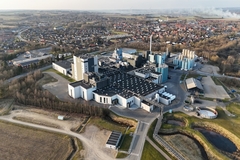
- Industry news
Industry news
- Category news
Category news
- Reports
- Key trends
- Multimedia
Multimedia
- Journal
- Events
- Suppliers
- Home
- Industry news
Industry news
- Category news
Category news
- Reports
- Key trends
- Multimedia
Multimedia
- Events
- Suppliers
Quest for the “perfect oat”: PepsiCo project leverages crop-boosting intelligence

17 Jan 2020 --- For the past five years, PepsiCo, alongside a number of academic partners including Cranfield University in the UK, has been analyzing how to make the “perfect oat.” Backed by the UK government’s Innovate agency, the “Opti-Oat” project has used technology to analyze hundreds of crops, collecting over one million data points. This has resulted in the Oat Growth Guide, pegged as the “world’s first” benchmark for creating the perfect oat and guidance on how to nurture it. FoodIngredientsFirst speaks to Dr. Mac McWilliam, R&D Director of Agro Discovery at PepsiCo, regarding the free guide, which is expected to improve yields by 5 to 10 percent – elevating the crop’s sustainability factor.

“Oats are an important crop in the UK – even more so at the moment due to their increasing popularity as a healthy breakfast choice. Yet unlike other staple cereal crops, such as wheat and barley, R&D investment to improve oat agronomy has been limited. This lack of information was seen as a barrier to growers to maximize their yield and quality,” says Dr. McWilliam.
Over four growing seasons, researchers of the project compiled detailed field measurements to track the growth and development of oats. In total, 120 commercial crops and 60 trial plots across four different seasons were analyzed, accumulating over one million data points.
The development of the Oat Growth Guide using the gathered data enables growers to assess the progress of their crops against the benchmarks in the guide and modify their management practices to improve yields and efficiency, ensuring a more sustainable, high quality supply of oats for consumers.
“The data is also being used to develop a Crop Intelligence Platform which uses satellite imaging, field data and weather to make predictions of crop growth stage, status and yield in different zones within a field to allow even more precise management of the crop,” explains Dr. McWilliam.
“Through these tools we aim to support our growers to increase yields by up to 10 percent, meaning more oats per hectare, while optimizing resources – a significant contribution to making oat a more sustainable crop,” he adds.
 Oats are a crop with relatively small amounts grown globally compared to other cereals like wheat, barley or rice.Open access guidance on crop yield elevation
Oats are a crop with relatively small amounts grown globally compared to other cereals like wheat, barley or rice.Open access guidance on crop yield elevation
Demand for oats has risen globally in recent years, mostly driven by health-conscious consumers attracted to the many health benefits of oats. One such example is that oats are a natural way to help lower blood cholesterol and are naturally high in dietary fiber. “Emerging research is exploring additional benefits such as for the gut microbiome which may be important for digestive health which is a key health trend. These benefits are aligned with the growing trend for natural, wholesome ingredients and foods,” Dr. McWilliam elaborates.
“While the humble oat has always had a reputation as a healthy breakfast choice, the development of oat products to be more accessible, through porridge on-the-go and overnight oats provide a convenient way for busy consumers to access these positive health benefits,” he adds.
Dr. McWilliam notes that, historically, oats have not attracted research investment because they are seen as a crop with relatively small amounts grown globally compared to other cereals like wheat, barley or rice. Moreover, survey data conducted in the UK has indicated that there is a yield gap of around four tons per hectare between average farm yields and optimal yields.
While all crops face challenges in increasing yields, oats have had particularly limited research, outlines Dr. McWilliam. “Our tools will allow our growers to move from traditional farming practices based on experience to a science-based production leveraging the latest technology.”
David Hay, Quaker Oats grower and owner of Hays Farms, explains that in the past, even experienced farmers have had to rely on a “try-and-test approach” to oat growing. This is often found to lead to inefficiencies and waste.
Meanwhile, a significant challenge for oat growers has been that higher yields do not always mean higher quality. “It is important for us to ensure high levels of beta-glucan, a type of dietary fiber recognized as having blood cholesterol-lowering properties, and a sought after attribute in oats. Our research aims to identify the factors and management practices to optimize beta-glucan in the grain,” says Dr. McWilliam.
At PepsiCo, over 100,000 metric tons of oats are processed through its mill in Scotland every year. “These oats are exported to 60 countries around the world so it's critical that we support our growers to meet this growing global market,” explains Dr. McWilliam.
“This is why we have given all growers access to the guide, without barriers, whether they grow Quaker oats or not. We want to raise the bar on oat production in general and this guide provides the foundation for existing growers as well as the next generation currently studying agriculture and crop science,” he adds.
“What’s more, Innovate UK’s investment helped to serve as a catalyst to bringing in a wide spectrum of partners. We are repaying that investment of public money by making the guide available to everyone, free of charge,” he concludes.
 Under the “farm tech revolution,” tech-fueled agricultural infrastructure is seeing a boom in investment.Tech-fueled farming
Under the “farm tech revolution,” tech-fueled agricultural infrastructure is seeing a boom in investment.Tech-fueled farming
Climate change, erratic weather events and a booming population are each factors affecting crop production that are motivating the expansion of tech-fueled infrastructure in the farming industry. Crop intelligence, in combination with “precision agriculture” is key to ensuring sustainable agri-food production and sourcing. In this scope, growers work closely with engineers to develop state-of-the-art technologies that help farmers gather data on their crops and improve growing practices, while using fewer resources.
“Opti-Oat is one such example of this emerging “farm tech revolution” where increasingly data and technology are as equally integral to agriculture as any other farm machinery. Farmers and growers have embraced this technology and really understand the importance of adopting these digital skills, and as time goes on we expect the benefits they bring to continue to grow,” concludes Dr. McWilliam.
Also within the agri-food tech space, US-based food safety company Neogen Corporation has recently released Igenity + Envigor – industry’s first genetic test that measures heterosis in crossbred cattle. In cattle breeding, heterosis is the term given to the tendency of a crossbred calf to show traits superior to those of its parents.
Earlier this month, a third class of the Microsoft- and Danone-backed AI Factory For AgriFood kicked off – fueling the synergies of regenerative agriculture, cloud computing and artificial intelligence (AI) technology in food chains.
Furthering precision farming, the Agricultural Nutrient Assistant (ANA) from Spacenus debuted to support farmers in fertilizing plants according to their needs. It helps prevent crop failures by using a smartphone to detect nutrient deficiency in plants at an early stage using smartphone and satellite images. AI is used, which evaluates the images and provides information on the supply of plants with the nutrients nitrogen, phosphorus, potassium, sulfur and magnesium.
Meanwhile, dairy giant Arla Foods currently utilizes AI in its 3D imagery systems to identify changes in physical well-being, mobility and weight in cows. The use of visual monitoring and data recording to assist in managing cow welfare is said to remove human subjectivity from health screening assessments.
Arla Foods has additionally developed an AI tool to better predict its milk intake from farms. According to the company, 200 million kilos of milk can now be utilized more efficiently each year, through predictions of how much milk 1.5 million cows will produce in the future, elevating value chain sustainability.
By Benjamin Ferrer










